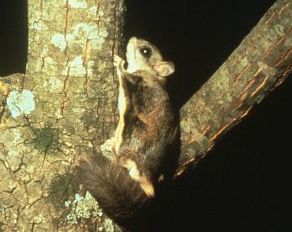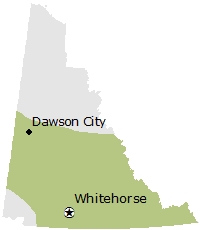
Name
- Common name: Northern Flying Squirrel
- Scientific name: Glaucomys sabrinus
- Order: Rodentia
- Family: Sciuridae
Also known as
Sometimes erroneously referred to as Sugar Gliders
Viewing opportunities
- During a Yukon summer, the dark hours are short and still fairly well lit. Since the squirrels will be more visible, this may be the best time to look for them in dense, mature spruce forests, or to visit a nest you may have located.
- Also watch for them landing on birdfeeders in your backyard.
- Many Yukoners are not aware that we have flying squirrels because they are rarely seen.
Description
- Brownish grey fur on the top surface of the body contrasts sharply with the pale, cream coloured underparts.
- Loose skin that extends from wrist to ankle is folded along its flanks when not "in flight."
- Flattened tail.
- Large luminous eyes.
Fast Facts
- Length: 27 cm
- Weight: 105 g
- Lifespan: 5 to 6 years
- Predators: Owls, foxes, weasels, marten, lynx and wolves
- Habitat: Boreal Forest
Conservation status
- Yukon: S4S5 (Apparently Secure/Secure)
- Global: G5 (Secure)
Yukon population estimate
Not determined.
Behaviour
Northern Flying Squirrels are nocturnal and unlike Red Squirrels, very sociable. Several adults may feed in a group and nests are often located close together. With the loose skin that stretches from wrist to ankle, the squirrels glide for a distance as they fall, but they can’t actually fly.
Food
Tree lichens, fungi, insects, bird eggs, and fledgling birds, buds, leaves, seeds and fruit.
Distribution

Sights and sounds

Northern Flying Squirrel track, hind: 1.3 x 1.3 cm.
Flying Squirrels and people
- They are occasionally caught in traps set for other furbearing animals, but the pelt has no market value.